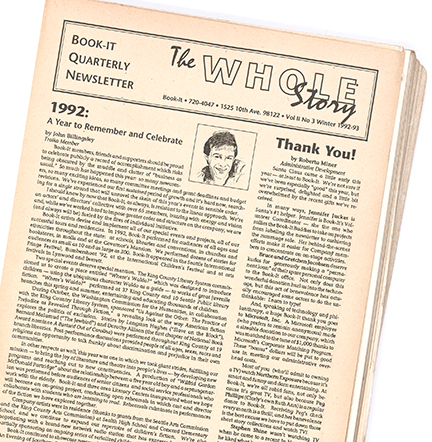
Remember how we did things back in the day when computers didn’t exist in everyone’s pocket and books weren’t powered by Kindle? Our trusty interns dusted off our filing cabinets and made some great discoveries about our past.
In the summer of 1991, Book-It published its very first quarterly newsletter, The Whole Story. Pre-email and pre-website, it was a good way to share company news. What started off as a four-page spread about the basics of each production, grew to six pages with more of a narrative for outsiders to get an idea of what’s going on behind the scenes.
The following is an article by Althea Hukari, taken from a 1992 issue. Learn what the Book-It adaptation process used to look like in the early days!
[medium]Making the Transition from Page to Stage[/medium]
by Althea Hukari, Core Company Member

One of Book-It’s greatest strengths as a theatre company is the diversity of its repertoire. Where do we find all those great stories? We read like crazy. Book-It runs on the readership of its members. In a very real way, it defines our company: Not only is a passion for literature one of the things which draws actors and directors to the company, setting Book-It apart from other theatre collectives, but the very stuff that is littering our individual bedside tables this month might end up gracing our collective stage in the months to come.
Where do we find all those great stories? We read like crazy. Book-It runs on the readership of its members.
Here’s how it works: A Book-It member finds a story she or he would love to “do.”—i.e. participate in staging as an actor or director… Falling in love with a story is no less idiosyncratic than falling in love with anything in this world; sometimes, we know precisely what draws us in: a certain character or relationship, a compelling story line or theme, a particular author’s language or imagery. Sometimes we love it without knowing why and plunge in, trusting the work to lead us to that discovery. Sometimes, a story almost transposes itself to the stage as we read it; other times it is that very challenge that intrigues us. In any case, step one is always read, read, read, until you get bit.
Step two is bringing your new-found love to a Book-It Reader. Readers are hosted every two weeks throughout the year at members’ homes. All members are welcome to participate, whether they bring something to read or not. (It’s a great way for new members to get to know what’s going on and for old members to catch up.) Stories are read round-robin style—we pass the book around and everyone takes a turn reading out loud.
it seems daunting,
it’s also exhilarating.
We log what we read, since presenting a story at a reader claims it, in Book-It parlance, as “your” story. This means it’s up to you to handle the many choices associated with getting the story to the stage. You ask for the feedback you want at the Reader, you determine who you’d like to work with, how you’d like to work, and pursue these options, you schedule rehearsal space, you secure performance rights, you check the calendar and arrange to put the story up at an In-House or determine a date for an in-company screening of your work. If this sounds like a lot riding on your shoulders, it is. Book-It members make Book-It happen. Everything your high school principal said about the responsibility of freedom is borne out by this process: is it seems daunting, it’s also exhilarating.
Book-It’s monthly In-Houses are the testing ground of our new works. They are a story’s first exposure to an audience and our first opportunity as company members to see each other’s work in progress.
Although they’ve come a long way from the old days, when our audience crowded on a couple of couches in an ill-lit acting studio, at heart they remain the same: They’re our chance to take any risk we deem necessary or desirable as artists, to create work without censure and without need to keep one eye on its commercial viability. The opportunity to present such work to an audience on a regular basis is one of the primary functions of our In-Houses.
In-Houses also serve as the first and crucial step in our “screening” process. Before any story can be accepted in the Book-It repertoire, it must be screened. This is a delicate process—and one that is still under revision—but its aim is simple: How do we insure that we put our best work forward as a company?
The sharing of stories, in essence,
is what Book-It is all about.
…All stories arise out of our human need to share ourselves with others, to make sense out of our own lives. Reading can seem like a solitary act, but, in fact, there are always two people involved: the author and the reader. A story cannot really be said to complete until it is communicated. The sharing of stories, in essence, is what Book-It is all about. So, next time you read a great story, share it with us.
Book-It’s Backstories is our ongoing series where we delve into our history, celebrating our 25th anniversary.